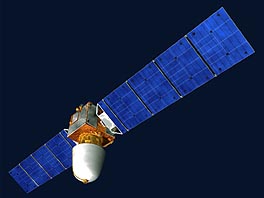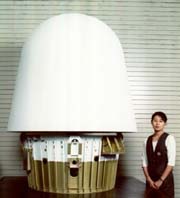Kawasaki Heat Shield Technology Helps Spacecraft Keep Its Cool
Jun. 25, 2003

|

|
| (C) JAXA |
Kawasaki’s heat shield technology used for re-entry into the earth’s atmosphere proved to be a great success for the next generation Unmanned Space Experiment Recovery System (USERS) developed by the Institute for Unmanned Space Experiment Free Flyer (USEF).
The Ministry of Economy, Trade and Industry and the New Energy Development Organization (NEDO) commissioned USEF to develop the USERS. USERS utilizes a Re-Entry Module (REM) allowing results of experiments in space to be retrieved from the earth’s surface without using such modes of transport as the space shuttle. It is anticipated the system will give impetus to future commercial development in space.
Kawasaki developed and manufactured the main structure and heat shield system used on the REM for the USERS. By using heat shield material called ablator, which is made from carbon fiber reinforced plastic, Kawasaki has succeeded in protecting the sensitive equipment that sits inside the REM from the intense heat and pressure produced upon re-entry. With this new heat-shield system, although temperatures rise to 2,300°C on the outside of the REM, the inside is kept under 230°C.
USERS was launched in September 2002 by the H-IIA Launch Vehicle No.3. The REM, which contained equipment for superconductive material experiments, re-entered the earth’s atmosphere after detaching itself from the experimental satellite service module in May 2003. It was then retrieved from the Pacific Ocean, southeast of Tokyo. This marked the first time Japan had succeeded in the ground-retrieval of a spacecraft and has resulted in Japan acquiring spacecraft retrieval technology while demonstrating the effectiveness of Kawasaki’s heat shield technology.





